To effectively monitor wildlife health remotely, start by selecting the right drone with high-quality cameras and long battery life. Master quiet flight techniques to minimize disturbance, using slower movements and flying at higher altitudes. Utilize thermal imaging technology to detect animals in low-light conditions and observe temperature variations. Implement AI-powered animal recognition systems to enhance tracking and population assessment. Establish consistent monitoring schedules tailored to species activity patterns and research objectives. By following these tips, you'll improve your ability to gather essential data on animal health and behavior. Discover how these strategies can revolutionize your conservation efforts.
Choose the Right Drone

When choosing a drone for remote wildlife health monitoring, it's crucial to select a model that meets your specific needs. Consider the terrain and climate where you'll be operating, as well as the size and behavior of the animals you're studying.
Opt for a drone with a high-quality camera capable of capturing clear images and videos from a distance. Look for models with long battery life and extended range to maximize your monitoring time.
Drones with obstacle avoidance systems and GPS capabilities will help you navigate safely around trees and other obstacles. Choose a quiet drone to minimize disturbance to wildlife, and make sure it's weather-resistant for various conditions.
Consider the payload capacity if you need to carry additional sensors or equipment. Some drones offer thermal imaging cameras, which can be useful for detecting animals in dense vegetation or at night.
Master Quiet Flight Techniques
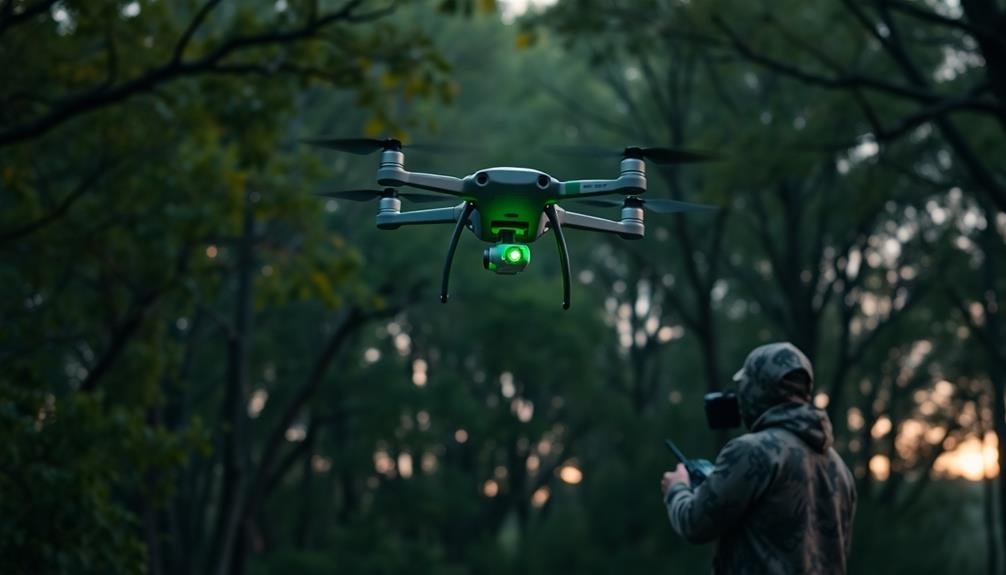
To minimize disturbance to wildlife, mastering quiet flight techniques is vital for remote health monitoring. Start by selecting propellers designed for quieter operation and make certain they're properly balanced to reduce vibration.
Adjust your drone's flight settings to favor slower, smoother movements, which generate less noise. When possible, fly at higher altitudes to diminish the sound reaching ground level.
Learn to utilize wind direction to your advantage. Flying downwind from your target animals can help mask the drone's noise. Practice maintaining a steady altitude and avoid sudden changes in speed or direction, which can create louder, more noticeable sounds.
Consider using a GPS-guided flight path to guarantee smooth, predictable movements.
Timing is essential. Plan your flights during periods when ambient noise is higher, such as early morning when birds are most active, to help mask your drone's presence.
If you're monitoring nocturnal animals, invest in a drone equipped with night vision capabilities to fly in darker, quieter conditions.
Always adhere to local regulations regarding drone use and wildlife observation to make sure your monitoring efforts remain ethical and legal.
Utilize Thermal Imaging Technology

Thermal imaging technology has revolutionized remote wildlife health monitoring. It allows you to detect and observe animals in low-light conditions or dense vegetation, where traditional methods fall short. You'll be able to spot wildlife based on their body heat, making it easier to track and assess their health without disturbing them.
When using thermal imaging cameras, focus on identifying heat signatures that stand out from the surrounding environment. Look for animal shapes and movement patterns to distinguish between species. You can detect signs of illness or injury by observing abnormal temperature variations in specific body parts.
To get the most out of thermal imaging, choose a camera with appropriate resolution and sensitivity for your target species. Learn to interpret thermal images correctly, considering factors like ambient temperature and time of day. Use this technology in conjunction with other monitoring methods for a thorough health assessment.
Remember that thermal imaging has limitations. It can't penetrate water or thick forest canopies, and it's less effective in extreme temperatures. Always combine thermal imaging with your knowledge of animal behavior and habitat for the best results in remote wildlife health monitoring.
Implement AI-Powered Animal Recognition

Artificial intelligence (AI) has become a game-changer in remote wildlife health monitoring. By implementing AI-powered animal recognition systems, you'll greatly enhance your ability to track and assess wildlife populations without disturbing their natural habitats.
These advanced algorithms can quickly analyze vast amounts of data from camera traps, drones, and satellite imagery, identifying individual animals and species with remarkable accuracy.
To implement AI-powered animal recognition, start by selecting a suitable software platform that integrates with your existing monitoring equipment. Train the AI model using a diverse dataset of images and videos from your target species, ensuring it can recognize animals in various poses, lighting conditions, and environments.
As you collect new data, continually refine the model to improve its accuracy and adapt to changing conditions.
You'll find that AI-powered recognition can detect subtle changes in an animal's appearance or behavior, potentially indicating health issues before they become severe. This early warning system allows for timely interventions and more effective conservation efforts.
Additionally, AI can help you identify patterns in wildlife movement, breeding behaviors, and population dynamics, providing valuable insights for long-term ecological studies and conservation strategies.
Establish Consistent Monitoring Schedules

Consistency is the backbone of effective remote wildlife health monitoring. You'll need to establish regular schedules for data collection and analysis to guarantee reliable insights into animal populations. Set up daily, weekly, and monthly routines that align with your research objectives and the behaviors of the species you're studying.
Consider these factors when creating your monitoring schedule:
| Time of Day | Species Activity |
|---|---|
| Dawn | Diurnal waking |
| Midday | Feeding periods |
| Dusk | Nocturnal waking |
| Night | Hunting/foraging |
| Seasonal | Migration/mating |
Tailor your schedule to capture key behavioral patterns and health indicators. For example, if you're monitoring nocturnal animals, focus on evening and night observations. Don't forget to account for seasonal variations that might affect animal behavior or health.
Use automated systems to maintain consistency in data collection. Set up your cameras, sensors, and other monitoring devices to operate on a predetermined schedule. This approach minimizes human interference and guarantees data is collected at the same times each day or week. Regular maintenance checks should also be part of your schedule to keep equipment functioning efficiently and prevent data gaps.
Frequently Asked Questions
How Do Local Wildlife Regulations Affect Remote Monitoring Practices?
You'll need to research local wildlife regulations carefully. They can affect where you're allowed to place monitoring devices, what species you can track, and how you handle any data collected. Always obtain necessary permits before starting.
What Safety Precautions Should Be Taken When Monitoring Potentially Dangerous Animals?
When monitoring dangerous animals, you'll need to prioritize your safety. Always maintain a safe distance, use protective gear, and don't work alone. Research the animal's behavior, carry communication devices, and have an escape plan ready.
How Can Data From Remote Monitoring Be Securely Stored and Shared?
You should use encrypted cloud storage for secure data sharing. Implement two-factor authentication and strict access controls. Don't forget to regularly back up your data and use secure file transfer protocols when sharing with colleagues.
What Ethical Considerations Should Be Addressed in Remote Wildlife Health Monitoring?
You should consider animal welfare, minimizing distress, and respecting habitats. Guarantee data privacy, obtain proper permits, and follow ethical guidelines. Don't interfere unnecessarily with wildlife behavior. Prioritize conservation goals over research interests when monitoring remotely.
How Does Weather Impact the Effectiveness of Remote Monitoring Equipment?
You'll find that weather greatly affects your remote monitoring equipment. Rain can damage sensors, extreme temperatures may cause malfunctions, and wind can disrupt signals. Sunlight impacts battery life, while fog or snow can obstruct camera views.
In Summary
You've now got the tools to revolutionize your wildlife health monitoring. By choosing the right drone, mastering quiet flight, using thermal imaging, implementing AI recognition, and maintaining consistent schedules, you'll minimize disturbance while maximizing data collection. Remember, it's not just about the technology—it's about respecting the animals and their habitats. With these tips, you're well-equipped to make a positive impact on wildlife conservation through remote monitoring techniques.
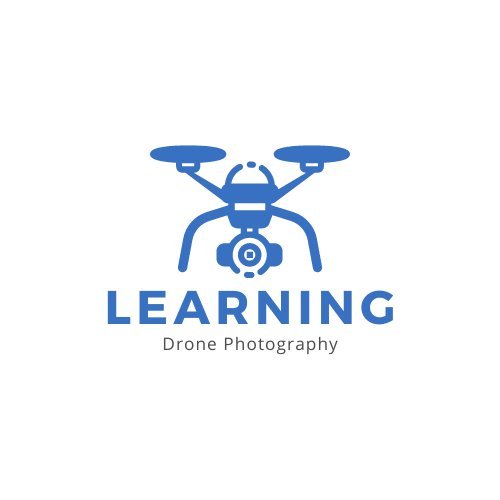
As educators and advocates for responsible drone use, we’re committed to sharing our knowledge and expertise with aspiring aerial photographers.
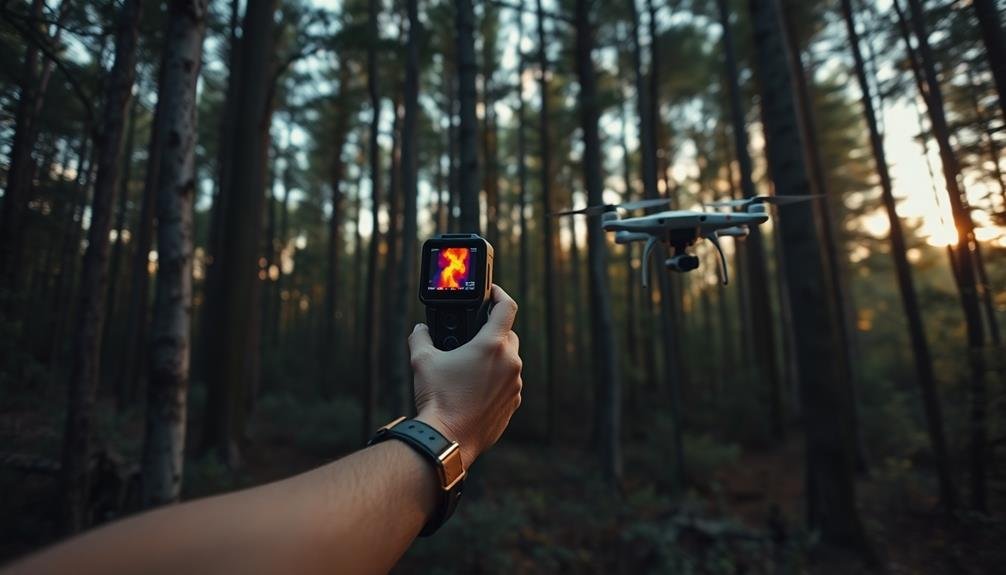
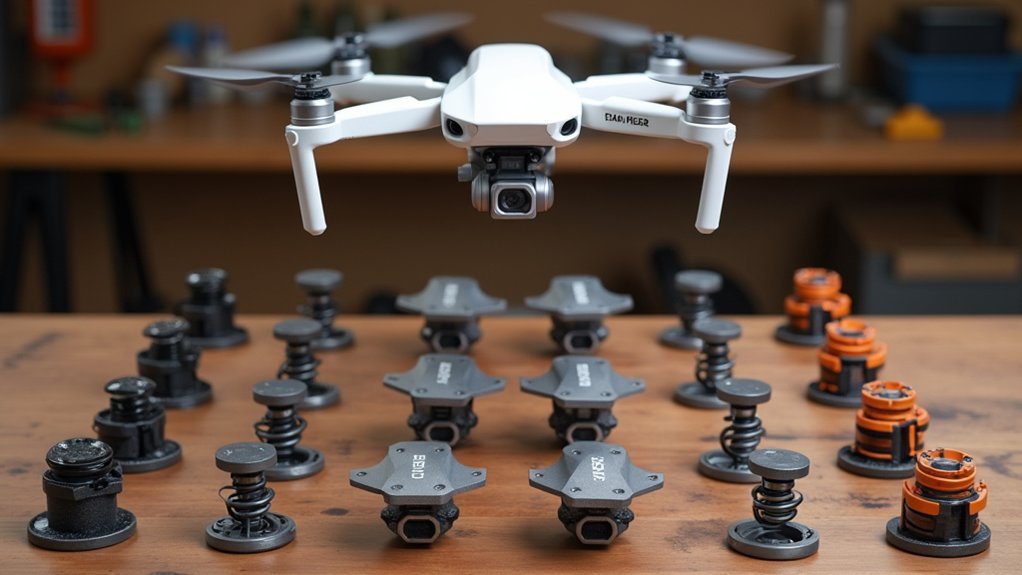

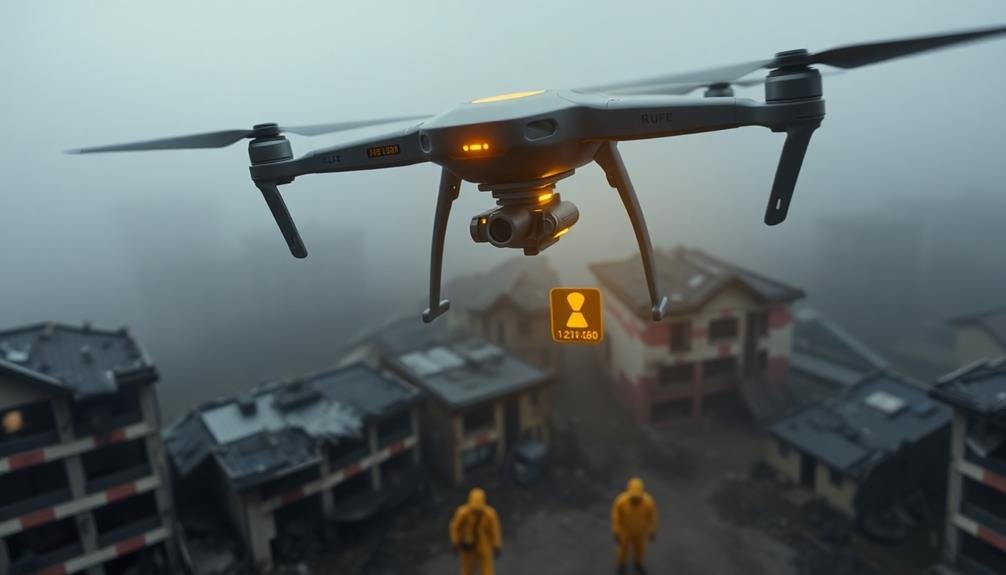
Leave a Reply